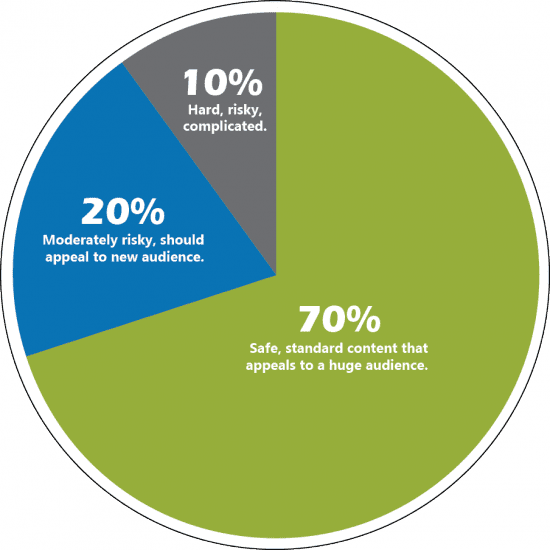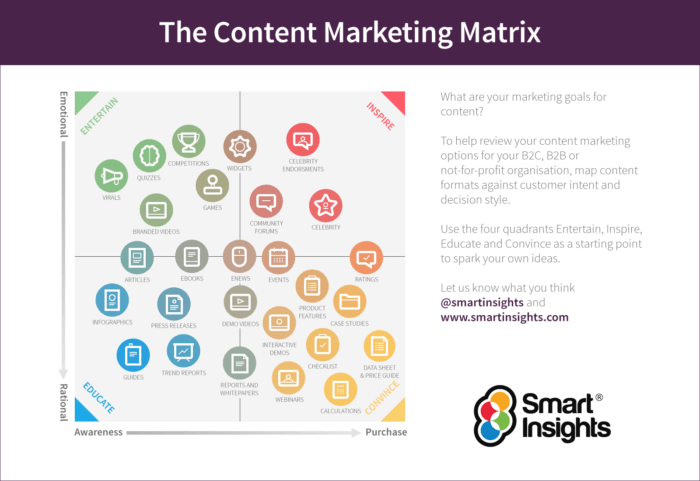How to use the power of the 70:20:10 rule as a marketing model to prioritize your digital marketing strategy
With new marketing tools and techniques available to us almost daily, it can be difficult to know where to prioritize your marketing activities to get the most 'bang for your buck'. This is where the 70:20:10 rule can really help, since it's a simple device which helps us think through how we prioritize the time and budget we put into different marketing activities.
As marketers, we need to be agile through reacting to new developments in order to gain an upper hand on competitors, but at the same time, we need to avoid being 'technology magpies' following seductive, shiny new tools that may distract us from working on optimizing the most effective channels. By splitting your spending or output into three differently sized areas, it helps you to identify priority areas, and allocate campaign budget as necessary.

The 70:20:10 model is flexible, and can be applied to a number of different areas of digital marketing. It's traditionally been applied in media or campaign budgets, but there are several interpretations of how businesses can use the rule in their own marketing strategies including content and social media marketing. Here are three key areas of resourcing digital marketing, along with suggestions on how the 70:20:10 rule can be utilised. Finally, we take a look at how it applies to learning and personal development.
Download Business Professional Member resource – Marketing budget spreadsheet template
This Smart Insights budgeting spreadsheet template has been created to provide a comprehensive checklist of modern marketing activities you need to budget for including managing digital experiences (mobile and web), content marketing and traditional offline channels.
Access the Marketing budget spreadsheet template
The 70:20:10 rule in Digital media investment
It can be tempting to stick to the tried-and-tested marketing methods that have worked so well in the past. For example, if AdWords drives sales at an acceptable CPA, then there will be a tendency to focus here. However, lack of agility, or 'putting all your eggs in one basket' has proved to be the downfall of many an established company, who have been unable to adapt to a rapidly-changing consumer or marketing technology landscape.
In digital media investment, Ashley Friedlein has suggested that 70% of your marketing should be 'marketing as usual'. This entails focusing on the marketing activities that have driven sales volume in the last couple of years, for example Search and affiliate marketing for a retailer. This should already be successful, and, of course, you will have built up an in-depth knowledge of how to go about things, so this 70% will be your bread and butter campaigns. He suggested that 20% of your marketing should also be 'programmatic', which is more rules-driven and automated in response to various stimuli; so it is not planned, but it is responsive, and, typically, machine-driven and executed. Finally, 10% of your marketing should be purely responsive - this is Oreo-style Real-time marketing.

Mark Renshaw of agency Leo Burnett/ Arc Worldwide, writing in Ad Age also suggests dividing spending into 70%, 20% and 10% 'buckets'. Again the 70% bucket is all about 'refining your record of success' of tried and tested media. He recommends applying the next 20% to media that have just gone mainstream or are on the verge of doing so, while the 10% are the opportunities that pop up frequently and quickly attract media attention.
The remaining 10% of your marketing should be responsive or 'agile', reacting to current events or news stories in a way in which customers can relate to. This approach isn't easy though, it requires the right creative people and process to be in place at your company.
The Content Distribution Matrix that we have created follows similar thinking, here the 70% is the high volume, high ROI activities in the bottom right quadrant. The 20% and 10% are in the top left low volume, low ROI category when media are first tested with a view to moving them into the bottom right if they're effective.

The 70:20:10 rule in content marketing
According to several creative and content blogs, the 70:20:10 model when applied to content marketing should be broken down by volume of different types of content as follows:
- 70% of content should be proven content that supports building your brand or attracting visitors to your site
- 20% of content should be premier content which may be more costly or risky but has a bigger potential new audience, for example 'viral videos' or infographics
- 10% of content should be more experimental
For example, Patricia Travaline writing in Social Media Today suggests that 70% of content should be proven – in much the same way as 'marketing as usual', this is the content that you know users are going to flock to, allowing you to build up a reputation as a reputable source. She believes that 20% of content should be 'premier' – i.e. more engaging and in-depth – and 10% should be experimental. This is similar to the suggestion by Michael Stelzner in his interesting book Launch where he has the nice simple suggestion that a content schedule should blend regular 'primary' fuel and exceptional, more risky 'nuclear fuel'. Many don't invest in the 'Nuclear option'.
Both of these interpretations of the 70:20:10 rule allow for a marketer to build a solid, reputable knowledge base for customers, provide content that is interesting and unusual and, when needed, self-promote in fun and unorthodox ways.
The 70:20:10 rule in social media marketing
In terms of social media, the eternal question is what types of content should a brand post? The 70:20:10 rule allows you to structure your updates, allowing your company to appear reputable, whilst simultaneously engaging the reader.
Western-Webs recently published this overview:
- 70% of Facebook posts should be proven content that supports building your brand
- 20% should be content from others, such as promoting another’s business or sharing interesting articles written by another and tagging
- 10% should be call-to-action in nature such as sales, discounts, introduction on new offerings, etc
This is the type of posting mix that we look to apply across different social networks - it's not just Facebook. Some might argue that you should share more than 20% of content from others, but many social feeds are too promotional.
You can see that the 70:20:10 rule in marketing is itself adaptable. That's its beauty - it can be applied to different aspects of budgeting time and resource. It's not a hard and fast rule - more the basis for discussion. In summary, if marketers focus the majority of their efforts on maintaining their brand (or indeed, building it), then they can allocate the rest of their marketing efforts on ensuring they resonate with consumers in an emotional way. By focusing a large percentage of your marketing budget on proven success, you are able to risk some of the remainder on areas of potential, which may prove highly profitable in years to come.

The 70:20:10 model in learning
Although we have seen that the 70:20:10 rule has been applied in lots of different ways within marketing, it's perhaps most commonly known as the 70:20:10 learning model which is useful for marketers to consider too.

The modern thinking is that the majority of learning is through doing and we should think about how we can extract and share learnings from this. With the Smart Insights resources we look to encourage that through offering Business Professional members the option to create a plan using our Digital Marketing workbook as they complete our online courses. Learning from trusted colleagues or mentors is the 20% while more formal classroom courses (we offer webinars to support this) and classroom reading provides a foundation and give qualifications to prove your level of knowledge through formal assessments.











